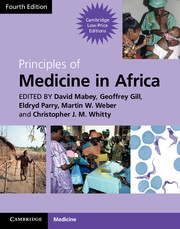Book contents
- Frontmatter
- Contents
- Contributors
- Foreword
- Section 1 Health and disease
- Section 2 Mother and child health
- Section 3 Infection: general principles
- Section 4 Major common infections
- 16 Malaria
- 17 HIV/AIDS
- 18 Tuberculosis
- 19 Pneumonia in adults
- 20 Meningitis
- 21 Sexually transmitted infections
- Section 5 Bacterial infections
- Section 6 Viral Infections
- Section 7 Protozoal infections
- Section 8 Helminth infections
- Section 9 Fungal infections
- Section 10 Non-communicable diseases
- Section 11 Diseases of body systems
- Section 12 Cancer and Palliative Care
- Section 13 Venoms and Poisons
- Index
- References
19 - Pneumonia in adults
from Section 4 - Major common infections
Published online by Cambridge University Press: 05 March 2013
- Frontmatter
- Contents
- Contributors
- Foreword
- Section 1 Health and disease
- Section 2 Mother and child health
- Section 3 Infection: general principles
- Section 4 Major common infections
- 16 Malaria
- 17 HIV/AIDS
- 18 Tuberculosis
- 19 Pneumonia in adults
- 20 Meningitis
- 21 Sexually transmitted infections
- Section 5 Bacterial infections
- Section 6 Viral Infections
- Section 7 Protozoal infections
- Section 8 Helminth infections
- Section 9 Fungal infections
- Section 10 Non-communicable diseases
- Section 11 Diseases of body systems
- Section 12 Cancer and Palliative Care
- Section 13 Venoms and Poisons
- Index
- References
Summary
The problem in Africa
For many decades pneumonia has ranked second only to malaria as a cause of admission to adult medical wards across Africa (Harries et al., 1990; Williams et al., 1986). However, in the last 25 years the pattern of hospital admissions has changed, reflecting the dominance of HIV-related problems. The two commonest reasons for admission among HIV-infected adults are tuberculosis and pneumonia (Grant et al., 1998), so pneumonia continues to present a considerable burden to hospital services across the continent.
Pneumonia affects economically productive people. Although its incidence is higher among those with chronic underlying diseases, the typical patient in Africa is a healthy individual with a short history of illness. Although mortality is higher in the elderly, the majority of pneumonia-related deaths in hospital occur among young adults, less than 40 years old. Furthermore, among survivors, 60 per cent of pneumonia patients have not recovered sufficiently to return to work 3 weeks after their admission (Scott et al., 2000).
Pneumonia is usually straightforward to diagnose and treat. The challenges in management are identifying the severely ill patient, predicting the aetiology of disease, dealing with resistance among respiratory pathogens and anticipating complications.
- Type
- Chapter
- Information
- Principles of Medicine in Africa , pp. 254 - 265Publisher: Cambridge University PressPrint publication year: 2013
References
- 1
- Cited by



